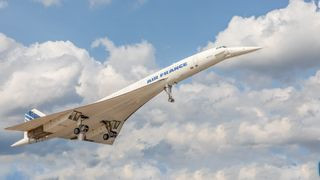The Concorde, a marvel of aviation history, famously slashed travel time between New York and London to a mere 2 hours, 52 minutes, and 59 seconds. This iconic supersonic jet wasn’t just fast; it was exceptionally fast, flying at more than twice the speed of sound. But just How Fast Could Concorde Fly, and what ingenious engineering allowed it to reach such incredible velocities?
To truly understand how fast Concorde could fly, we need to delve into its operational speeds. During takeoff, Concorde reached speeds of around 250 mph (402 km/h). Once airborne and cruising, this speed dramatically increased to an average of 1,350 mph (2,173 km/h). To put this into perspective, a modern and common airliner like the Boeing 737-700 has a takeoff speed of approximately 173 mph (278 km/h) and cruises at about 514 mph (828 km/h). Concorde, therefore, didn’t just outpace contemporary jets; it operated in a different league entirely, achieving speeds more than twice as fast during cruise.
The Engineering Genius Behind Concorde’s Velocity
Achieving such remarkable speeds required groundbreaking engineering. Concorde’s designers faced the complex challenge of creating an aircraft that could perform efficiently at both low speeds, necessary for takeoff and landing, and at supersonic cruising speeds. According to Tony Farina, an aviation engineering expert at Embry‑Riddle Aeronautical University, designing a wing that excels at supersonic speeds is inherently problematic for low-speed performance. Supersonic wings are typically thin and swept back to minimize drag, whereas standard wings are thicker to generate lift more effectively at lower speeds.
Lift is a crucial factor, especially as speed increases. Bob van der Linden, an aeronautics curator at the Smithsonian’s National Air and Space Museum, explains that drag force intensifies as an aircraft accelerates, counteracting lift. Concorde’s engineers ingeniously tackled this issue by incorporating several key design features. The aircraft boasted a sleek, streamlined body, including a narrow passenger cabin and a long, pointed tail cone, all contributing to reduced drag. Furthermore, they adopted a delta wing design, a triangular wing shape typically seen in fighter jets.
 Concorde supersonic passenger plane in flight against a sky with light clouds
Concorde supersonic passenger plane in flight against a sky with light clouds
The Concorde airplane showcasing its delta wing design while flying, highlighting its aerodynamic profile for supersonic speed.
“The delta wing provided both excellent high-speed and surprisingly good low-speed characteristics,” van der Linden noted. This innovative wing design minimized drag while still enabling controlled takeoff and landing. However, the delta wing and overall aircraft shape introduced a unique challenge: a high angle of attack during landing, obstructing pilot visibility.
To overcome this, Concorde was equipped with a “droop nose,” or “droop snoot.” This ingenious mechanism allowed the aircraft’s nose to be mechanically lowered, giving pilots a clear view of the runway during takeoff and landing. Modern supersonic aircraft, like the Boom Supersonic XB-1 currently under development, are utilizing advanced augmented vision systems to solve this visibility issue, technology not available when Concorde was designed in the 1960s.
Powering Supersonic Flight: Engines and Fuel
Beyond its aerodynamic design, Concorde’s speed was also a product of its powerful engines. It was propelled by four turbojet engines, each generating a massive 18.7 tons of thrust. These engines, however, were incredibly fuel-hungry, consuming nearly 7,000 gallons (26,000 liters) of jet fuel per hour. In stark contrast, a Boeing 737-800 uses approximately 850 gallons (3,200 liters) of fuel per hour.
Concorde also employed afterburners, a technology primarily used in military fighter jets and high-speed bombers. Afterburners inject raw fuel directly into the engine’s exhaust flame, creating a significant boost in thrust for even greater acceleration. While effective in pushing Concorde to its remarkable speeds, afterburners drastically increased fuel consumption.
Ultimately, the immense fuel costs associated with maintaining supersonic speeds proved to be a major factor in Concorde’s commercial challenges. Combined with other events, such as the tragic Air France Flight 4590 crash in 2000, Concorde’s operational lifespan was limited.
Despite its eventual retirement, Concorde remains an aviation icon. As van der Linden aptly summarized, “It is a gorgeous airplane. But to keep it that fast, you need a lot of power. Power means a lot of fuel, and a lot of fuel means a bigger price.” Concorde’s legacy is a testament to human ingenuity, pushing the boundaries of speed and engineering, even if it ultimately highlighted the economic realities of supersonic commercial flight.